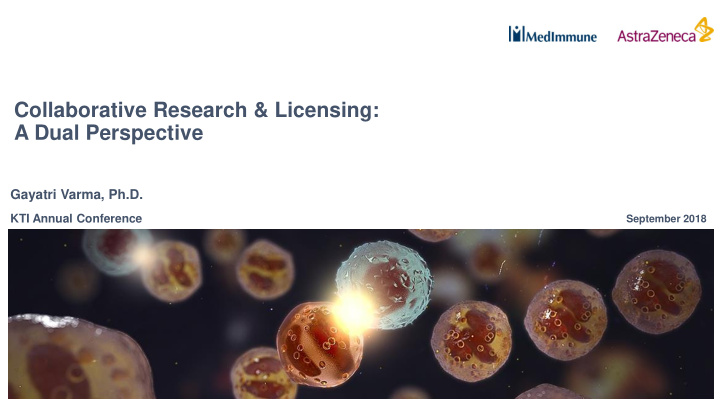



Collaborative Research & Licensing: A Dual Perspective Gayatri Varma, Ph.D. KTI Annual Conference September 2018
Why Collaborate (Industry)? • Science forms the basis of all programs • Training students, post docs, clinicians • Clinical trials • Consulting agreements • Employee pipeline • Publications
Why Collaborate (Academic Entity)? • Ability to participate in translational research • Training of industry workforce • Sponsored research dollars • Potential to license any resultant IP
Research Collaborations Master Research Agreements • What’s in this for the industry? • Streamlined negotiations • Potentially competitive rates • Easy to add projects/workstreams • What’s in this for the academic entity? • Streamlined negotiations • Sometimes guaranteed a certain number of projects/year or $s/year • Predictability on $$s coming in for research • Potentially jointly owned patents
Research Collaborations Master Research Agreements • Are there issues with this? • For the company? • Strategy may shift • Tied to a single entity in terms of commitment of projects • Scientists don’t want to be forced into a collaboration; does not make for an ideal partner • For the academic entity? • Funding committed to a limited number of academic entities • Company strategy shifts • Termination of projects
Research Collaborations 1:1 Agreements • Organically initiated • Positives • Very specific to the strategy • Based exclusively on strength of science • Easy mechanism to collaborate across several academic institutions • Negatives • Have to negotiate every single contract • More time, less efficient
Case Study #1 Example of working with University 1 – a positive experience!
Case Study #2 Example of working with University 2 – an experience!
Successful Collaborations • Communication, communication, communication • One point of contact at the academic institution • Clear understanding of the needs of the company • Alignment on deliverables set by parties • Continued engagement with academic institution • Licensing of IP generated • Joint Patent applications
Not as Successful Collaborations • Lack of communication • No clear understanding of the needs of the company (timelines/budget) • No alignment on deliverables or often a misunderstanding set by parties • Termination of contract • In all likelihood company will not go back to work with that institution
Licensing • Has to be aligned with company strategy • Even if joint IP generated and many positive results, if company strategy shifts there will be no license agreement • Financials will be based on whether the company funded the research • More investment in research project, lower the numbers in a license • IP ownership • Amount of investment will dictate IP ownership terms
Take Home Lessons • Successful collaboration supports the mission of each partner • Collaboration is a 2-way street • Managing expectations • The company is not a cash cow • Academic IP is often a piece of a 50/100 piece puzzle, not the puzzle itself • Set realistic expectations on the value/contribution of the academic IP to the product that is commercialized
Take Home Lessons (contd) • Often the company has Plan B, C, and D in their back pockets, so easy for them to walk away • When engaging with the company, keep lines of communication open • Focus on the long term partnerships • Continued effort required
Recommend
More recommend